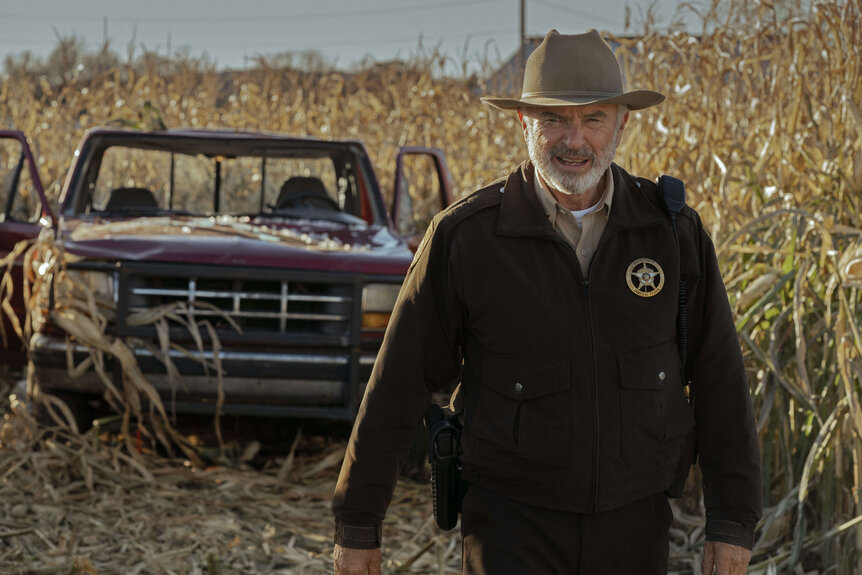Create a free profile to get unlimited access to exclusive videos, sweepstakes, and more!
'Invasion' is a global, slow-burn alien attack like you’ve never seen, showrunners say
Invasion, the new Apple TV+ series, wants to show what an alien invasion might be like from a human perspective, on the ground and around the globe.

Aliens have invaded Earth! ...If you’ve watched any science fiction, you’ve probably heard that one before. The creators of Invasion, an aptly titled new series on Apple TV+, know it’s hardly the first bit of fiction to explore the possibilities of an extra-terrestrial landing. Showrunners Simon Kinberg (executive producer of several X-Men movies as well as The Martian) and David Weil (Amazon’s Hunters) both readily admit that their series is heavily inspired by H.G. Wells’ War of the Worlds — and especially Orson Welles’ panic-inducing 1938 radio play adaptation. What Invasion wants to do is show what an alien invasion might be like from a human perspective, on the ground and around the globe.
Speaking to SYFY WIRE ahead of the show’s Oct. 22 premiere, Kinberg says his vision for the series was “Welles’ War of the World meets Babel,” the acclaimed 2006 ensemble drama from director Alejandro G. Iñárritu.
“You’d be watching a real drama with real people who would be interesting enough even if aliens never showed up,” Kinberg says. “And then you’d be taking all their problems and issues and emotional stuff and you’d put it under the magnifying glass of an alien invasion and just blow it up to the size and scale and scope that we know of that genre.
Invasion focuses on a diverse cast of characters — a heartland sheriff, an immigrant wife in a failing marriage, an isolated soldier in Afghanistan, a bullied English youth, a closeted Japanese scientist — as they separately comprehend a world-changing experience. Aliens, who largely loom in the margins for the first several episodes, have seemingly come to Earth and nobody knows what’s going on. The characters have their own issues before the aliens arrived, something that Kinberg says was a helpful connection in determining which half-dozen or so of the world’s 8 billion people they wanted to focus on.
“In working on the X-Men movies, I got a lot of experience working with ensembles. The ones that worked were the ones where there was a singular idea, thematic or emotional, that unified them even though their stories were very diverse,” Kinberg explains. “In this case, the thematic idea was that they were all alienated in their lives before the aliens showed up. They were outsiders in their lives or they were separate from their lives in some ways before this catastrophic thing happens. This catastrophic thing just blows up their lives into a much bigger stage.”
“We wanted this alien invasion story to be one that an audience could see themselves in,” says Weil, noting that none of the characters — at least, not yet — are the alien-fighting protagonist of a more action-adventure sort of alien invasion story. “This isn’t Tom Cruise or Will Smith running down the street saving humanity. We wanted this to feel like people who our global audience could connect to.”
Kinberg cites Close Encounters of the Third Kind and Arrival as touchstones for Invasion, as they’re both similarly focused on the human perspective. However, he echoes Weil’s mention of a global audience.
“What those stories do is they tell it from — even something like Independence Day — they tell it from primarily or entirely from an American point of view,” Kinberg says. “I was really interested in doing a global story where you had different people all over the planet in different continents in different cultures dealing with a common threat.”
“One that we certainly wanted to confront is the centering and positioning of the white western male hero in the larger alien invasion genre is ubiquitous,” Weil adds. “We were excited about turning that convention on its head and exploring an alien invasion series through the lens of people who felt alienated in their own lives in their own world.”
(Savvy viewers might note here that the promotion for the show has heavily focused on Sam Neil’s character, who is clearly a white man playing an American. It makes some sense, given that he is the highest-profile member of the cast, but things are not always what they seem. “In the show as a whole, we want to play with conventions and turn them on their head and defy expectations,” teases Weil.)
The alien invasion in Invasion is not exactly lightning-paced. The first five episodes of the 10-episode first season keep the aliens mysterious and in the background, focusing instead on the human drama. (Things do pick up as the show goes on, particularly with an action-packed sixth episode, and Kinberg promises that the “scale and spectacle and the action” ramp up as the season progresses.) Both showrunners say they hope the slow burn generates a greater empathy for the characters as things escalate.
“We certainly do foreground the characters themselves and less so the aliens in those first few episodes, but we are building towards a greater payoff that I think will be even more thrilling and feel even more real because we perpetuated that investment,” Weil says.
Kinberg adds that there’s another reason why Invasion starts slow — that’s what would happen in a real invasion.
“I don’t think an alien invasion would be spaceships showing up and blowing up the White House,” he says. “I think — and this is not just my own conjecture, it’s also from talking to people at NASA and the Pentagon and experts in alien life — it would be something where, if there was a visitation or an invasion, it would happen gradually. It would be mysterious… It wouldn’t come as a big wave, it would come as a series of the tides shifting.”
And, while Invasion’s gradual pace keeps the focus initially on the humans, it is very much an alien invasion show. Meaning, yes, there are aliens — and Invasion’s aliens do distinguish themselves in a genre that’s had no shortage of attempts to create unique alien life.
“I worked with Ridley Scott on The Martian and we talked a lot about his design for Alien and how influential that’s been for pretty much every alien design since,” Kinberg says before explaining how Invasion set about making something new. “We talked a lot, both with experts and then our visual effects team, about creating an organic-feeling alien. Having a unified and thought-through physics and biology for that alien, so that we could really classify it even though it’s unknowable. We could classify the genus for what that species is. We looked at hundreds of concept drawings. We had everybody, the best in the world from WETA on down, looking at designs for us. We finally found a few that felt like they were new and fresh and different and also had their own organic, biological reality to them.”
As for what’s next for Invasion, Kinberg and Weil both say that the series (and by extension, the invasion) will only get bigger as the season — and possibly the series — continues.
“Season 1, let’s call it the arrival,” Weil says. “Season 2 is contending with that arrival, how do we reorient? Season 3 — if we’re so lucky to have a Season 2 and 3 — we’ll kind of slow-burn an alien invasion in real-time.”
The first three episodes of Invasion are now streaming on Apple TV+. New episodes will premiere every Friday.




























